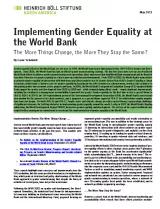Implementing Gender Equality at the World Bank
Policy Paper
Implementing Gender Equality at the World Bank
The More Things Change, the More They Stay the Same?
Gender equality efforts at the World Bank are not new. In 1994, the World Bank issued Operational Policy (OP) 4.20 on Gender and Development. Since 2001, the World Bank has had an official gender mainstreaming strategy. The last few years have seen an acceleration of World Bank efforts to address gender mainstreaming in its operations; these underscore that both World Bank management and its Board of Executive Directors see gender equality as a key to poverty reduction and development. From 2007 to 2010, the World Bank’s main vehicle to promote gender equality in interactions with both donor and client countries was its Gender Action Plan (GAP), Gender Equality as Smart Economics, which made a business case for gender equality by focusing on the role of women as entrepreneurs, workers and customers in integrating gender into economic sector projects and loans. Gender equality for the first time is also a special theme in IDA 16 (2011 to 2014), the 16th replenishment period of the International Development Association (IDA), the World Bank’s concessional loan window for the poorest of its client countries, and is proposed as a special theme again for IDA 17 for which donor country negotiations have just begun. Lastly, in 2012 the World Bank’s flagship publication, the World Development Report (WDR), focused on gender equality and development. The release of the report worldwide was coupled with a management commitment to accelerate the implementation of gender equality at the World Bank.
Several recent World Bank and external reports have taken stock of how successfully gender equality concerns have been mainstreamed in World Bank activities in the past few years. These reports highlight some successes and improvements, but also some persistent weaknesses in implementation, which point at structural and policy shortcomings of the World Bank approach to gender mainstreaming that, despite the flurry of activities of recent years, have not yet been overcome. A closer look at the World Bank’s internal gender monitoring and accountability effort reveals that these efforts prioritize monitoring processes over results by focusing on gender-flagging or gender-coding World Bank activities generously, rather than tracing gender equality impacts of World Bank programs and projects in client countries. In this respect, in the World Bank’s gender treatment there is the serious danger that the more things change (especially procedurally), the more things stay the same (particularly in terms of development approach and gender equality impacts).
Related documents:
- Update on the Implementation of the Gender Equality Agenda at the World Bank Group (September 21, 2012)
- IDA 16 Mid-Term Review Progress Report: Accelerating Progress on Gender Mainstreaming and Gender-related MDGs (September 2012)
- Gender Review of the World Bank’s Climate Investment Funds (October 26, 2012)
